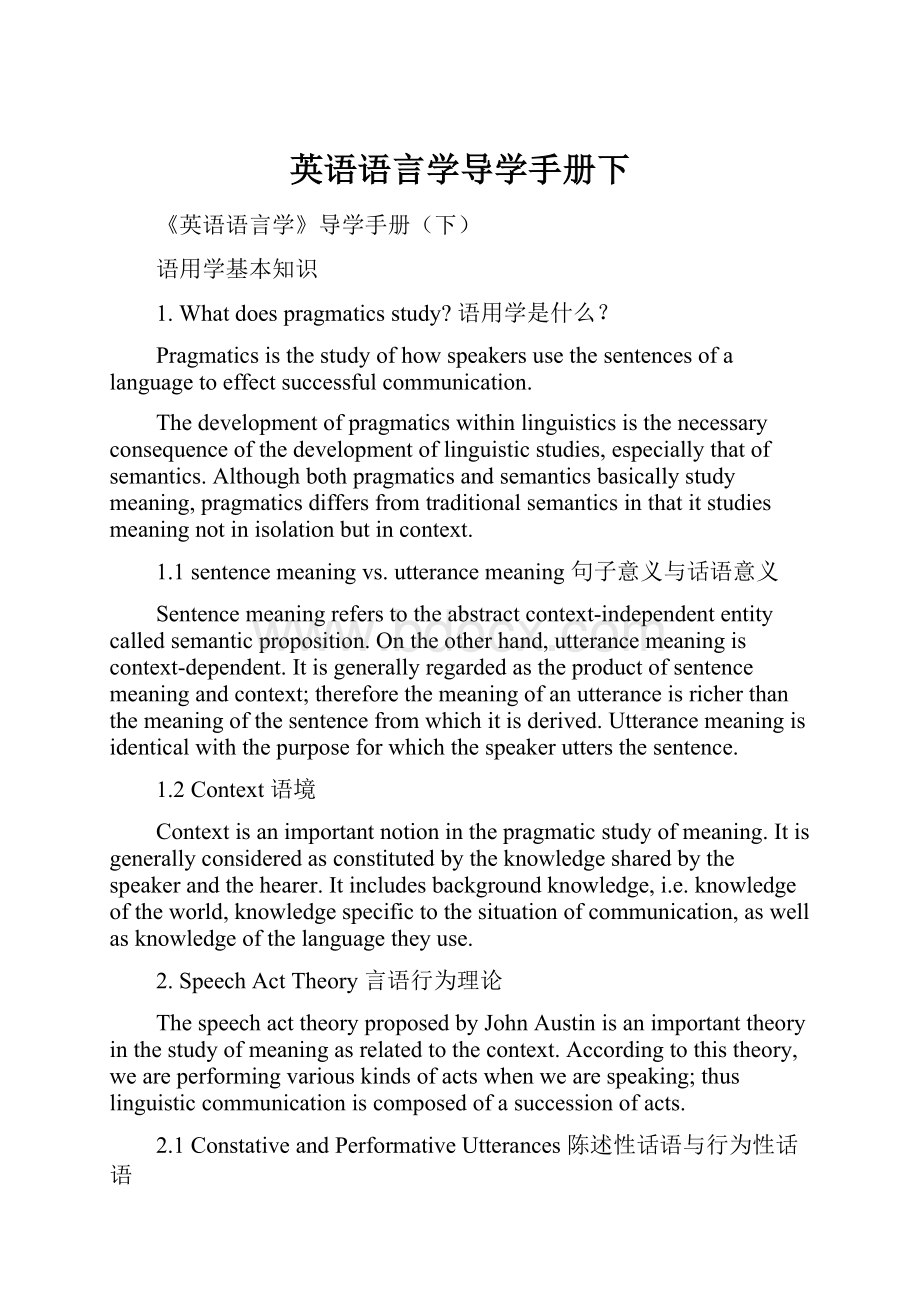英语语言学导学手册下.docx
《英语语言学导学手册下.docx》由会员分享,可在线阅读,更多相关《英语语言学导学手册下.docx(28页珍藏版)》请在冰豆网上搜索。

英语语言学导学手册下
《英语语言学》导学手册(下)
语用学基本知识
1.Whatdoespragmaticsstudy?
语用学是什么?
Pragmaticsisthestudyofhowspeakersusethesentencesofalanguagetoeffectsuccessfulcommunication.
Thedevelopmentofpragmaticswithinlinguisticsisthenecessaryconsequenceofthedevelopmentoflinguisticstudies,especiallythatofsemantics.Althoughbothpragmaticsandsemanticsbasicallystudymeaning,pragmaticsdiffersfromtraditionalsemanticsinthatitstudiesmeaningnotinisolationbutincontext.
1.1sentencemeaningvs.utterancemeaning句子意义与话语意义
Sentencemeaningreferstotheabstractcontext-independententitycalledsemanticproposition.Ontheotherhand,utterancemeaningiscontext-dependent.Itisgenerallyregardedastheproductofsentencemeaningandcontext;thereforethemeaningofanutteranceisricherthanthemeaningofthesentencefromwhichitisderived.Utterancemeaningisidenticalwiththepurposeforwhichthespeakeruttersthesentence.
1.2Context语境
Contextisanimportantnotioninthepragmaticstudyofmeaning.Itisgenerallyconsideredasconstitutedbytheknowledgesharedbythespeakerandthehearer.Itincludesbackgroundknowledge,i.e.knowledgeoftheworld,knowledgespecifictothesituationofcommunication,aswellasknowledgeofthelanguagetheyuse.
2.SpeechActTheory言语行为理论
ThespeechacttheoryproposedbyJohnAustinisanimportanttheoryinthestudyofmeaningasrelatedtothecontext.Accordingtothistheory,weareperformingvariouskindsofactswhenwearespeaking;thuslinguisticcommunicationiscomposedofasuccessionofacts.
2.1ConstativeandPerformativeUtterances陈述性话语与行为性话语
Austinfirstmadetheprimarydistinctionbetweentwotypesofutterances:
constativeandperformative.Theconstativeutteranceisverifiableanditiseithertrueorfalse.Theperformativeutteranceisusedoperformanactionandhasnotruevalue.ButAustinwasnotsatisfiedwithit;hefinallyconductedanewmodel.
2.2Austin’sNewModel奥斯汀的新模式
AccordingtoAustin’snewmodel,aspeaker,whilemakinganutterance,isinmostcasesperformingthreeactssimultaneously.
a)ALocutionaryAct以言指事行为
Alocutionaryactistheactofsayingsomething;itistheactofconveyingliteralmeaningbymeansofsyntax,lexiconandphonology.
b)AnIllocutionaryAct以言做事行为
Anillocutionaryactistheactperformedinsayingsomething;itsforceisidenticalwiththespeaker’sintention.
c)APerlcutionaryAct以言成事行为
Aperlocutionaryactistheactperformedbyorresultingfromsayingsomething;itistheconsequenceof,orthechangebroughtaboutbytheutterance.
2.3Searle’sContributionstotheSpeechActTheory斯尔对言语行为理论的贡献
a)TheDistinctionandRelatednessbetweenthePropositionalContentandIllocutionaryAct
Thepropositionalcontentofanutteranceisconstitutedbywhatobjectisbeingreferredtointheutteranceandwhatactionispredicatedabouttheobject.
b)TheClassificationofIllocutionaryAct以言做事行为的分类
SearlespecifiesfivegeneraltypesofIllocutionaryacts
(1)Representatives阐述类
Theillocutionarypointoftherepresentativesistocommitthespeakertosomething’sbeingthecase,tothetruthoftheexpressedproposition.Inotherwords,whileperformingthistypeofact,thespeakerismakingastatementorgivingadescriptionwhichhehimselfbelievestobetrue.Stating,believing,swearing,hypothesizingareamongthemosttypicaloftherepresentatives.
(2)Directives指令类
Directivesareattemptsbythespeakertogetthehearertodosomething.Inviting,suggesting,requesting,warning,threatening,orderingareallspecificinstanceofthisclass.
(3)Commissives承诺类
Commissivesarethoseillocutionaryactswhosepointistocommitthespeakertosomefuturecourseofaction.Promising,undertaking,vowingarethemosttypicalcases.
(4)Expressives表达类
Theillocutionarypointofexpressivesistoexpressthepsychologicalstatespecifiedinthepropositionalcontent.Thespeakerisexpressinghisfeelingsandattitudestowardstheexistingstateofaffairs,e.g.apologizing,thanking,congratulating.
(5)Declarations宣布类
Thelastclass‘declarations’hasthecharacteristicthatthesuccessfulperformanceofanactofthistypebringsaboutthecorrespondencebetweenthepropositionalcontentandreality.
3.PrinciplesofConversation会话原则
3.1TheCo-operativePrinciple合作原则
Inmakingconversation,thereis,asGriceholds,ageneralprinciplewhichallparticipantsareexpectedtoobserve.HecallsthisguidingprincipletheCooperativePrinciple.Hefurtherspecifiesfourmaxims:
a)TheMaximofQuantity量的准则
(1)Makeyourcontributionasinformativeasrequired.
(2)Donotmakeyourcontributionmoreinformativethanisrequired.
b)TheMaximofQuality质的准则
(1)Donotsaywhatyoubelievetobefalse.
(2)Dotnotsaythatforwhichyoulackadequateevidence.
c)TheMaximofRelation关系准则
Berelevant
d)TheMaximofManner方式准则
(1)Avoidobscurityofexpression.
(2)Avoidambiguity
(3)Bebrief.
(4)Beorderly.
Thesemaximsarenotalwaysstrictlyobserved.Rather,forvariousreasonstheyareoftenviolated.SomeoftheseviolationsgiverisetowhatGriceterms“conversationalimplicatures”.Inotherwords,whenweviolateanyofthesemaxims,ourlanguagemightbecomeindirect.
3.2ThePolitenessPrinciple礼貌
Thecooperativeprincipleexplainshowconversationalimplicatureisgivenrisetobutitdoesnottelluswhypeopleareoftensoindirectinconveyingwhattheywanttosay.Thisiswherethepolitenessprinciplecomesin.Inthemostgeneralterms,thepolitenessprinciplecanbeformulatedas“maximize”theexpressionofpolitebeliefs”,or,initsnegativeform,“Minimizetheexpressionofimpolitebeliefs.
Thepolitenessprincipleseemstohaveahigherregulativerolethanthecooperativeprinciplebecauseitrequiresforsmoothandeffectivecommunication.
Exercises
I.MatcheachofthefollowingtermsincolumnAwithoneoftheappropriatedefinitionsincolumnB:
ColumnAcolumnB
1.locutionaryactA.Thespeakerisexpressinghisfeelingsandattitudestowardsthe
existingstateofaffairs,
2.illocutionaryactB.Thelastclass‘declarations’hasthecharacteristicthatthe
successfulperformanceofanactofthistypebringsaboutthe
correspondencebetweenthepropositionalcontentandreality.
3.perlocutionaryactC.Theconstativeutteranceisverifiableanditiseithertrueorfalse.
4.representativesD.Theperformativeutteranceisusedoperformanactionandhas
notruevalue.
5.directivesE.Commissivesarethoseillocutionaryactswhosepointisto
committhespeakertosomefuturecourseofaction.
6.CommisivesF.Alocutionaryactistheactofsayingsomething;itistheactof
conveyingliteralmeaning.
7.expressivesG.Theillocutionarypointoftherepresentativesistocommitthe
speakertosomething’sbeingtheare,tothetruthofthe
expressedproposition.
8.DeclarationsH.Aperlocutionaryactistheactperformedbyorresultingfrom
sayingsomething;itistheconsequenceof,orthechange
broughtaboutbytheutterance.
9.constativeutteranceI.Directivesareattemptsbythespeakertogetthehearertodo
something.
10.performativeutteranceJ.Anillocutionaryactistheactperformedinsayingsomething;its
forceisidenticalwiththespeaker’sintention.
II.Explaineachofthefollowingtermsinnomorethan50words:
1.pragmatics2.utterancemeaning3.representatives
4.expressives5.commissives6.politenessprinciple
7.locutionaryact8.Illocutionaryact9.Perlocutionaryact
III.Developoneofthefollowingtopicsintoa200-wordessay:
1.Austin’sspeechacttheory.
2.Cooperativeprinciple.
VIII.LanguageChange语言的变化
本章的学习目的要求
本章学习的中心内容是语言的变化。
全章含研究语言变化的目的与意义、语言变化的本质、英语的历史发展、语系和语言变化的原因等五部分。
本章的学习目的是让学生了解语言的发展史及其变迁规律。
通过学习本章,学生可以从历史发展的角度来深刻认识语言的过去、现在和未来之间的关系,掌握语言历史演变的成因和规律,了解语言群体在其历史变迁中所形成的旁系与直系关系。
语言变化的基本知识
1.Introduction引言
Itisafactthatalllanguageschangethroughtime,thoughtheydosoratherslowly.Wherelanguageshavewrittenrecords,itispossibletoseetheactualchangesthathavetakenplace.
2.SoundChange语音变化
Soundchangestendtobesystematic;itispossibletoseearegularpatternofpronunciationchangesthroughoutthelanguage.Forexample,
WordsMiddleEnglishModernEnglish
Mice[mi:
s][mais]
Mouse[mu:
s][maus]
3.MorphologicalandSyntacticChange形态和句法变化
Morphologicalandsyntacticchangesalsotakeplaceinprogress,forexample,changein“agreement”rule,innegationrule,processofsimplification,lossofinflections,etc.
4.VocabularyChange词汇变化
Vocabularychangecaninclude:
additionofnewwords,lossofwordsandchangesinthemeaningofwords.
4.1AdditionofNewWords增加新词
a)Coinage创新词
Anewwordcanbecoinedorinventedoutrighttofitsomepurpose,e.g.
dacronkodaxerox
b)ClippedWords缩略词
Clippingreferstotheabbreviationoflongerwordsorphrases,e.g.
gym(gymnastics)fridge(refrigerator)disco(discotheque)
c)Blending紧缩法
Ablendisawordformedbycombiningpartsofotherwords,e.g.
smog(smoke+fog)motel(motor+hotel)flurry(flutter+hurry)
d)Acronyms词首字母缩略词
Acronymsarewordsderivedfromtheinitialsofseveralwords,e.g.
Radar(Radiodetectingandranging)U.S.A(theUnitedStatesofAmerica)
e)Back-formation逆生成法
Newwordsmaybecoinedfromalreadyexistingwordsby“subtracting”anaffixthoughttobepartoftheoldword,e.g.
Edit(derivedfromeditor)
f)FunctionalShift功能转移
Wordsmayshiftfromonepartofspeechtoanotherwithouttheadditionofaffixes,e.g.
g)Borrowing借用
Whenculturescomeintocontact,wordsareoften“borrowed”fromonelanguagetoanother,e.g.
education(fromLatin)cycle(fromGree